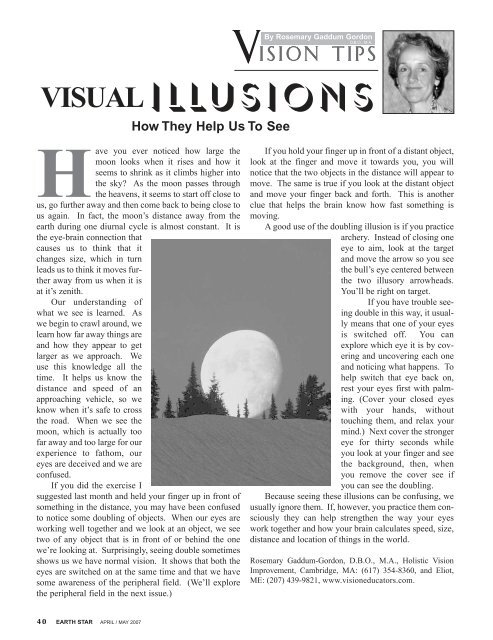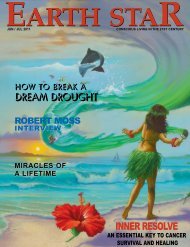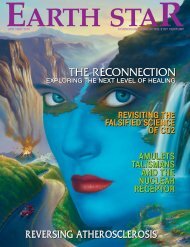You also want an ePaper? Increase the reach of your titles
YUMPU automatically turns print PDFs into web optimized ePapers that Google loves.
By Rosemary Gaddum GordonD.B.O., M.A.VI S I O N T I P SVISUAL ILLUSIONSHow They Help Us To SeeHave you ever noticed how large themoon looks when it rises and how itseems to shrink as it climbs higher intothe sky? As the moon passes throughthe heavens, it seems to start off close tous, go further away and then come back to being close tous again. In fact, the moon’s distance away from theearth during one diurnal cycle is almost constant. It isthe eye-brain connection thatcauses us to think that itchanges size, which in turnleads us to think it moves furtheraway from us when it isat it’s zenith.Our understanding ofwhat we see is learned. Aswe begin to crawl around, welearn how far away things areand how they appear to getlarger as we approach. Weuse this knowledge all thetime. It helps us know thedistance and speed of anapproaching vehicle, so weknow when it’s safe to crossthe road. When we see themoon, which is actually toofar away and too large for ourexperience to fathom, oureyes are deceived and we areconfused.If you did the exercise Isuggested last month and held your finger up in front ofsomething in the distance, you may have been confusedto notice some doubling of objects. When our eyes areworking well together and we look at an object, we seetwo of any object that is in front of or behind the onewe’re looking at. Surprisingly, seeing double sometimesshows us we have normal vision. It shows that both theeyes are switched on at the same time and that we havesome awareness of the peripheral field. (We’ll explorethe peripheral field in the next issue.)If you hold your finger up in front of a distant object,look at the finger and move it towards you, you willnotice that the two objects in the distance will appear tomove. The same is true if you look at the distant objectand move your finger back and forth. This is anotherclue that helps the brain know how fast something ismoving.A good use of the doubling illusion is if you practicearchery. Instead of closing oneeye to aim, look at the targetand move the arrow so you seethe bull’s eye centered betweenthe two illusory arrowheads.You’ll be right on target.If you have trouble seeingdouble in this way, it usuallymeans that one of your eyesis switched off. You canexplore which eye it is by coveringand uncovering each oneand noticing what happens. Tohelp switch that eye back on,rest your eyes first with palming.(Cover your closed eyeswith your hands, withouttouching them, and relax yourmind.) Next cover the strongereye for thirty seconds whileyou look at your finger and seethe background, then, whenyou remove the cover see ifyou can see the doubling.Because seeing these illusions can be confusing, weusually ignore them. If, however, you practice them consciouslythey can help strengthen the way your eyeswork together and how your brain calculates speed, size,distance and location of things in the world.Rosemary Gaddum-Gordon, D.B.O., M.A., Holistic VisionImprovement, Cambridge, MA: (617) 354-8360, and Eliot,ME: (207) 439-9821, www.visioneducators.com.40 EARTH STAR APRIL / MAY 2007
















